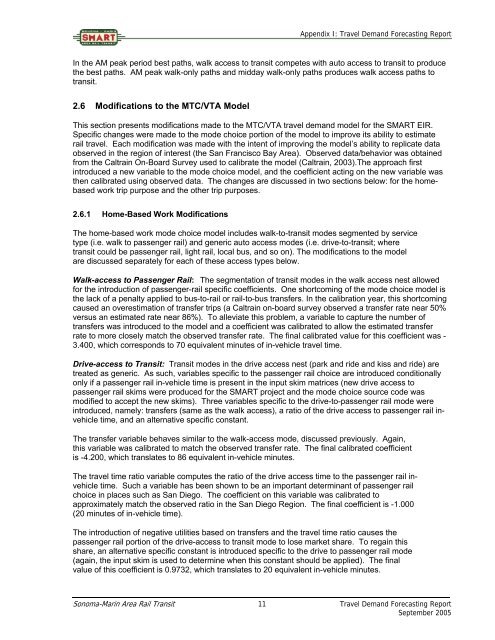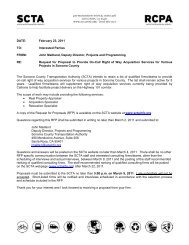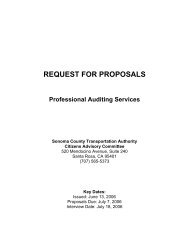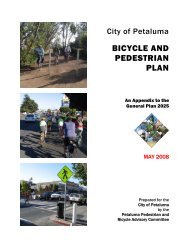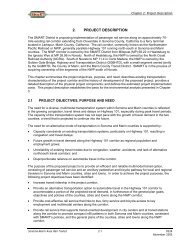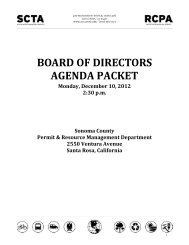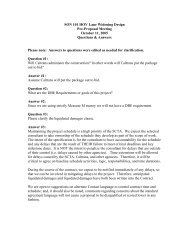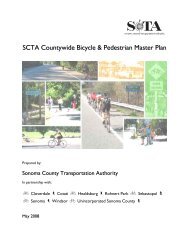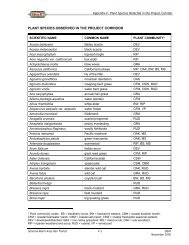travel demand forecasting report - Sonoma County Transportation ...
travel demand forecasting report - Sonoma County Transportation ...
travel demand forecasting report - Sonoma County Transportation ...
You also want an ePaper? Increase the reach of your titles
YUMPU automatically turns print PDFs into web optimized ePapers that Google loves.
Appendix I: Travel Demand Forecasting Report<br />
In the AM peak period best paths, walk access to transit competes with auto access to transit to produce<br />
the best paths. AM peak walk-only paths and midday walk-only paths produces walk access paths to<br />
transit.<br />
2.6 Modifications to the MTC/VTA Model<br />
This section presents modifications made to the MTC/VTA <strong>travel</strong> <strong>demand</strong> model for the SMART EIR.<br />
Specific changes were made to the mode choice portion of the model to improve its ability to estimate<br />
rail <strong>travel</strong>. Each modification was made with the intent of improving the model’s ability to replicate data<br />
observed in the region of interest (the San Francisco Bay Area). Observed data/behavior was obtained<br />
from the Caltrain On-Board Survey used to calibrate the model (Caltrain, 2003).The approach first<br />
introduced a new variable to the mode choice model, and the coefficient acting on the new variable was<br />
then calibrated using observed data. The changes are discussed in two sections below: for the homebased<br />
work trip purpose and the other trip purposes.<br />
2.6.1 Home-Based Work Modifications<br />
The home-based work mode choice model includes walk-to-transit modes segmented by service<br />
type (i.e. walk to passenger rail) and generic auto access modes (i.e. drive-to-transit; where<br />
transit could be passenger rail, light rail, local bus, and so on). The modifications to the model<br />
are discussed separately for each of these access types below.<br />
Walk-access to Passenger Rail: The segmentation of transit modes in the walk access nest allowed<br />
for the introduction of passenger-rail specific coefficients. One shortcoming of the mode choice model is<br />
the lack of a penalty applied to bus-to-rail or rail-to-bus transfers. In the calibration year, this shortcoming<br />
caused an overestimation of transfer trips (a Caltrain on-board survey observed a transfer rate near 50%<br />
versus an estimated rate near 86%). To alleviate this problem, a variable to capture the number of<br />
transfers was introduced to the model and a coefficient was calibrated to allow the estimated transfer<br />
rate to more closely match the observed transfer rate. The final calibrated value for this coefficient was -<br />
3.400, which corresponds to 70 equivalent minutes of in-vehicle <strong>travel</strong> time.<br />
Drive-access to Transit: Transit modes in the drive access nest (park and ride and kiss and ride) are<br />
treated as generic. As such, variables specific to the passenger rail choice are introduced conditionally<br />
only if a passenger rail in-vehicle time is present in the input skim matrices (new drive access to<br />
passenger rail skims were produced for the SMART project and the mode choice source code was<br />
modified to accept the new skims). Three variables specific to the drive-to-passenger rail mode were<br />
introduced, namely: transfers (same as the walk access), a ratio of the drive access to passenger rail invehicle<br />
time, and an alternative specific constant.<br />
The transfer variable behaves similar to the walk-access mode, discussed previously. Again,<br />
this variable was calibrated to match the observed transfer rate. The final calibrated coefficient<br />
is -4.200, which translates to 86 equivalent in-vehicle minutes.<br />
The <strong>travel</strong> time ratio variable computes the ratio of the drive access time to the passenger rail invehicle<br />
time. Such a variable has been shown to be an important determinant of passenger rail<br />
choice in places such as San Diego. The coefficient on this variable was calibrated to<br />
approximately match the observed ratio in the San Diego Region. The final coefficient is -1.000<br />
(20 minutes of in-vehicle time).<br />
The introduction of negative utilities based on transfers and the <strong>travel</strong> time ratio causes the<br />
passenger rail portion of the drive-access to transit mode to lose market share. To regain this<br />
share, an alternative specific constant is introduced specific to the drive to passenger rail mode<br />
(again, the input skim is used to determine when this constant should be applied). The final<br />
value of this coefficient is 0.9732, which translates to 20 equivalent in-vehicle minutes.<br />
<strong>Sonoma</strong>-Marin Area Rail Transit 11 Travel Demand Forecasting Report<br />
September 2005


